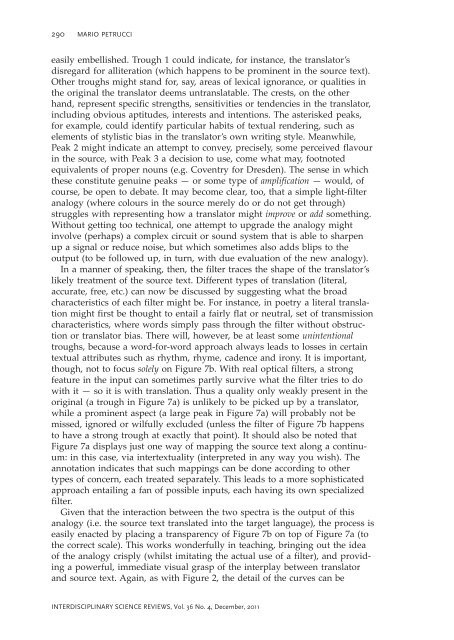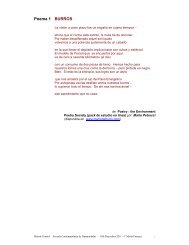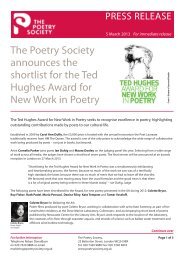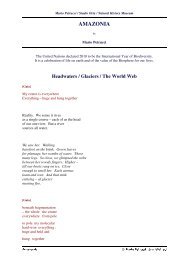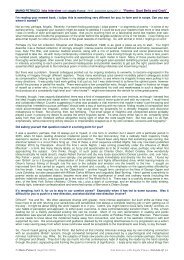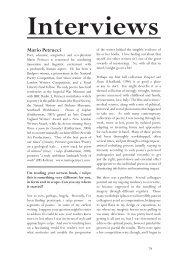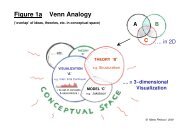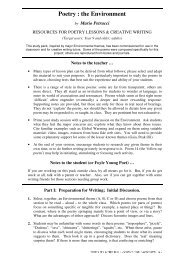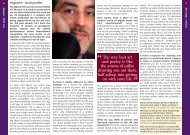Scientific Visualizations: Bridge-Building between ... - Mario Petrucci
Scientific Visualizations: Bridge-Building between ... - Mario Petrucci
Scientific Visualizations: Bridge-Building between ... - Mario Petrucci
Create successful ePaper yourself
Turn your PDF publications into a flip-book with our unique Google optimized e-Paper software.
290 MARIO PETRUCCI<br />
easily embellished. Trough 1 could indicate, for instance, the translator’s<br />
disregard for alliteration (which happens to be prominent in the source text).<br />
Other troughs might stand for, say, areas of lexical ignorance, or qualities in<br />
the original the translator deems untranslatable. The crests, on the other<br />
hand, represent specific strengths, sensitivities or tendencies in the translator,<br />
including obvious aptitudes, interests and intentions. The asterisked peaks,<br />
for example, could identify particular habits of textual rendering, such as<br />
elements of stylistic bias in the translator’s own writing style. Meanwhile,<br />
Peak 2 might indicate an attempt to convey, precisely, some perceived flavour<br />
in the source, with Peak 3 a decision to use, come what may, footnoted<br />
equivalents of proper nouns (e.g. Coventry for Dresden). The sense in which<br />
these constitute genuine peaks — or some type of amplification — would, of<br />
course, be open to debate. It may become clear, too, that a simple light-filter<br />
analogy (where colours in the source merely do or do not get through)<br />
struggles with representing how a translator might improve or add something.<br />
Without getting too technical, one attempt to upgrade the analogy might<br />
involve (perhaps) a complex circuit or sound system that is able to sharpen<br />
up a signal or reduce noise, but which sometimes also adds blips to the<br />
output (to be followed up, in turn, with due evaluation of the new analogy).<br />
In a manner of speaking, then, the filter traces the shape of the translator’s<br />
likely treatment of the source text. Different types of translation (literal,<br />
accurate, free, etc.) can now be discussed by suggesting what the broad<br />
characteristics of each filter might be. For instance, in poetry a literal translation<br />
might first be thought to entail a fairly flat or neutral, set of transmission<br />
characteristics, where words simply pass through the filter without obstruction<br />
or translator bias. There will, however, be at least some unintentional<br />
troughs, because a word-for-word approach always leads to losses in certain<br />
textual attributes such as rhythm, rhyme, cadence and irony. It is important,<br />
though, not to focus solely on Figure 7b. With real optical filters, a strong<br />
feature in the input can sometimes partly survive what the filter tries to do<br />
with it — so it is with translation. Thus a quality only weakly present in the<br />
original (a trough in Figure 7a) is unlikely to be picked up by a translator,<br />
while a prominent aspect (a large peak in Figure 7a) will probably not be<br />
missed, ignored or wilfully excluded (unless the filter of Figure 7b happens<br />
to have a strong trough at exactly that point). It should also be noted that<br />
Figure 7a displays just one way of mapping the source text along a continuum:<br />
in this case, via intertextuality (interpreted in any way you wish). The<br />
annotation indicates that such mappings can be done according to other<br />
types of concern, each treated separately. This leads to a more sophisticated<br />
approach entailing a fan of possible inputs, each having its own specialized<br />
filter.<br />
Given that the interaction <strong>between</strong> the two spectra is the output of this<br />
analogy (i.e. the source text translated into the target language), the process is<br />
easily enacted by placing a transparency of Figure 7b on top of Figure 7a (to<br />
the correct scale). This works wonderfully in teaching, bringing out the idea<br />
of the analogy crisply (whilst imitating the actual use of a filter), and providing<br />
a powerful, immediate visual grasp of the interplay <strong>between</strong> translator<br />
and source text. Again, as with Figure 2, the detail of the curves can be<br />
INTERDISCIPLINARY SCIENCE REVIEWS, Vol. 36 No. 4, December, 2011


